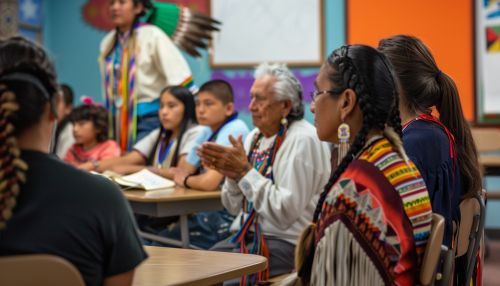Native American Languages Act: Difference between revisions
No edit summary |
No edit summary |
||
| Line 24: | Line 24: | ||
Since its enactment, the Native American Languages Act has had a significant impact on the revitalization of Native American languages. Many tribes have developed language programs and schools that focus on teaching their native languages to younger generations. The act has also led to increased federal funding and support for language preservation initiatives. | Since its enactment, the Native American Languages Act has had a significant impact on the revitalization of Native American languages. Many tribes have developed language programs and schools that focus on teaching their native languages to younger generations. The act has also led to increased federal funding and support for language preservation initiatives. | ||
[[Image:Detail-92633.jpg|thumb|center|Classroom with Native American students learning their native language from an elder.]] | [[Image:Detail-92633.jpg|thumb|center|Classroom with Native American students learning their native language from an elder.|class=only_on_mobile]] | ||
[[Image:Detail-92634.jpg|thumb|center|Classroom with Native American students learning their native language from an elder.|class=only_on_desktop]] | |||
One notable example is the [[Hawaiian Language Immersion Program]], which has successfully revitalized the Hawaiian language through immersive education. Similar programs have been established for other Native American languages, such as Navajo, Cherokee, and Ojibwe. | One notable example is the [[Hawaiian Language Immersion Program]], which has successfully revitalized the Hawaiian language through immersive education. Similar programs have been established for other Native American languages, such as Navajo, Cherokee, and Ojibwe. | ||
Latest revision as of 06:42, 19 June 2024
Native American Languages Act
The Native American Languages Act (NALA) is a significant piece of legislation in the United States that was enacted to preserve, protect, and promote the rights and freedoms of Native Americans to use, practice, and develop their languages. This act acknowledges the historical suppression of Native American languages and seeks to reverse the damage done by previous federal policies.
Historical Context
The suppression of Native American languages began with the arrival of European settlers and continued through various federal policies aimed at assimilating Native Americans into mainstream American culture. The Indian Boarding Schools were a prominent example of such policies, where Native American children were prohibited from speaking their native languages and were often punished for doing so. These schools aimed to eradicate Native cultures and languages, which led to a significant decline in the number of fluent speakers.
Legislative Background
The Native American Languages Act was passed by the United States Congress and signed into law by President George H.W. Bush on October 30, 1990. The act is codified at 25 U.S.C. §§ 2901-2906. The legislation was a response to the growing recognition of the importance of preserving Native American languages as a vital part of the cultural heritage and identity of Native American tribes.
Provisions of the Act
The Native American Languages Act contains several key provisions aimed at supporting the revitalization and maintenance of Native American languages:
- **Policy Declaration**: The act declares it to be the policy of the United States to preserve, protect, and promote the rights and freedom of Native Americans to use, practice, and develop their languages.
- **Support for Education**: The act encourages and supports the use of Native American languages as a medium of instruction in schools and other educational settings. It promotes the development of bilingual and bicultural education programs.
- **Federal Support**: The act mandates that federal agencies work with Native American tribes to ensure that their language rights are respected and supported. It also calls for the provision of technical assistance and funding for language preservation programs.
- **Recognition of Language Rights**: The act recognizes the inherent rights of Native American tribes to use their languages in all areas of life, including education, government, and public affairs.
Impact and Implementation
Since its enactment, the Native American Languages Act has had a significant impact on the revitalization of Native American languages. Many tribes have developed language programs and schools that focus on teaching their native languages to younger generations. The act has also led to increased federal funding and support for language preservation initiatives.


One notable example is the Hawaiian Language Immersion Program, which has successfully revitalized the Hawaiian language through immersive education. Similar programs have been established for other Native American languages, such as Navajo, Cherokee, and Ojibwe.
Challenges and Criticisms
Despite the progress made under the Native American Languages Act, there are still significant challenges to the revitalization of Native American languages. Many languages are critically endangered, with only a few fluent speakers remaining. The loss of elders who are fluent speakers poses a significant threat to the survival of these languages.
Critics of the act argue that while it provides a strong policy framework, it lacks sufficient funding and resources to fully support language revitalization efforts. There is also a need for more comprehensive data on the status of Native American languages to better inform policy and program development.
Future Directions
The future of Native American language revitalization depends on continued support from federal, state, and tribal governments, as well as the dedication of Native American communities. Efforts to document and archive languages, train new language teachers, and develop innovative language learning technologies are critical to ensuring the survival of these languages.
In recent years, there has been a growing movement to integrate Native American languages into digital platforms and media. This includes the development of language apps, online courses, and social media content in Native languages. These efforts aim to make language learning more accessible and engaging for younger generations.
Conclusion
The Native American Languages Act represents a significant step towards recognizing and supporting the linguistic and cultural rights of Native American tribes. While challenges remain, the act has provided a foundation for the revitalization of Native American languages and has inspired a renewed commitment to preserving this vital aspect of Native American heritage.
